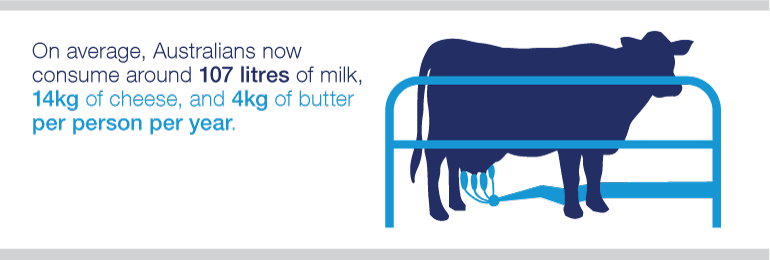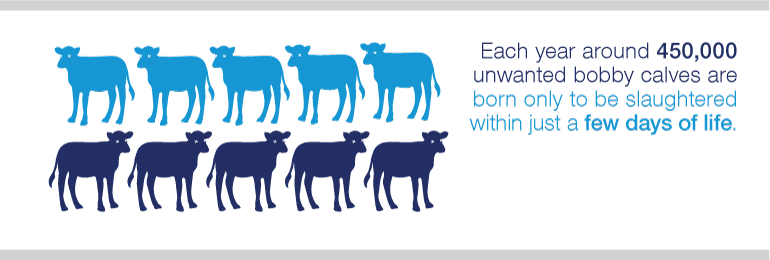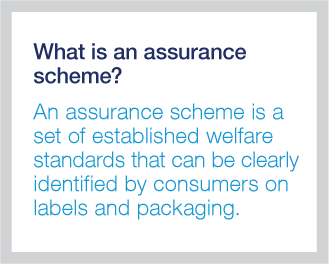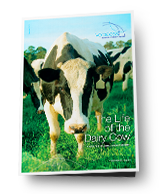
Over the past three decades, Australian dairy cows have been selectively bred and reared to significantly increase their average lactation from over 2,900 litres to an astonishing 5,900 litres of milk per cow annually.1 This genetic manipulation has significantly impacted the welfare of the dairy cow.
The demand for milk has led to Australian dairy cows increasingly being moved off-pasture to indoor production systems and fed unnatural, grain-based diets.2
Continuous milk production
Many people picture dairy cows living within traditional farming systems, and believe they are naturally producing enough milk to both feed their young and provide for human consumption.
In reality, dairy cows are subjected to a continuous cycle of calving, milking and impregnation,3 which can take a serious toll on their welfare.4

Due to this continuous cycle, mother cows may become susceptible to painful diseases like lameness6 and mastitis.7 Standard on-farm mutilation practices such as tail docking, disbudding and dehorning may also cause her and her offspring pain and distress,8 and can be performed without pain relief in some jurisdictions.9
In as little as seven or eight years, milking cows become worn out and when their milk yield falls, or they have repeated bouts of mastitis or lameness, they are slaughtered.10
Repeated pregnancies
Like other mammals, a mother cow must give birth in order to produce milk.
To ensure she continues to produce high volumes of milk throughout her life, a dairy cow is forcibly impregnated so that she gives birth to a new calf every 13 months.11
Typically, her calf will be taken from her within just 12 hours of birth.12 Separation can be stressful for both mother and calf,13 as a strong maternal bond can form between them in as little as five minutes.14 Over the days following separation, a mother cow can bellow day and night in search of her calf, often returning to the place where the calf was last seen.15
Bobby calves
As a result of these forced pregnancies, every year hundreds of thousands of calves are born into the dairy industry. While a proportion of female calves are kept as replacements for the milk producing herd, those females who are not required and all male calves are considered ‘wastage’ and are slaughtered shortly after birth.16
Each year around 450,000 unwanted dairy calves (known as bobby calves) are born and either killed on-farm or sent for commercial slaughter within just five days of being born.17 The vast majority of calves are separated from their mothers, given a last feed and then loaded onto trucks bound for sale yards and slaughterhouses for use in pet food, leather goods, the pharmaceutical industry or for veal.18
Those calves who stay on-farm are legally permitted be slaughtered by chemical euthanasia, the use of a firearm or a captive bolt, or through blunt force trauma.19

Regulations and law reform
Domestic and international demand for dairy produce is booming but the price of Australian milk has declined steeply in recent years.21 To compete commercially, Australian dairy farmers have been forced to maximise production while reducing their overall operative costs.
The implications of high production dairying on the modern dairy cow are immense and it is a critical factor in almost all the welfare concerns which exist in today’s industry.
One of the easiest ways to ensure consumers have the information they need to make informed and ethical food choices is through assurance schemes. Like schemes currently in use in the egg, meat chicken and pork industries, a dairy assurance scheme would enable dairy producers to grow and market their products in accordance with a set of established welfare standards.
Establishing nationally recognised dairy industry assurance schemes would give consumers the opportunity to make a genuine choice to purchase higher welfare dairy produce, and in turn, incentivise producers to improve on-farm practices.
Beyond that, there is an urgent need to introduce legal protections to better protect Australian dairy cows and their calves from the welfare issues they face in the modern dairy industry.
Learn more
- To find out more about the Australian dairy industry, read Voiceless’s report ‘The Life of the Dairy Cow’.
Last updated October 2018
- 1. ‘Yield’ (2012) http://www.dairyaustralia.com.au/Markets-and-statistics/Production-and-s…
- 2. Steve Little, ‘Feeding Systems Used by Australian Dairy Farmers’ (2010) <ttp://www.dairyaustralia.com.au/~/media/Documents/Animal%20management/Feed%20and%20nutrition/Feeding%20Systems%20latest/Aus%20five%20main%20feeding%20systems.pdf>.
- 3. John House, ‘A guide to dairy herd management’ (2011, LiveCorp and Meat and Livestock Australia), <http://www.livecorp.com.au/sites/default/files/publication/file/a_guide_to_dairy_herd_management.pdf>.
- 4. See, for example, John Webster quoted in Jeffrey Moussaieff Masson, The Face on Your Plate: The Truth About Food (W. W. Norton & Company, 2010) 84.
- 5. Australian Bureau of Agricultural and Resource Economics And Sciences (ABARES) (2013), ‘Agricultural Commodity Statistics 2013’ at 63. <http://data.daff.gov.au/data/warehouse/agcstd9abcc002/agcstd9abcc0022013/ACS_2013_1.0.0.pdf>, accessed 1 October 2014.
- 6. Lameness is a structural or functional condition which usually affects a cow’s limbs inhibiting her ability to walk, stand up, lie down or move around. See Voiceless, the animal protection institute (Voiceless), ‘Chapter 4.1: Lameness’, The Life of the Dairy Cow – A report into the Australian dairy industry (2015), <https://voiceless.org.au/reading-list-item/the-life-of-the-dairy-cow/>.
- 7. Mastitis is an inflammation of the mammary gland caused by the invasion of bacteria into the udder. See Voiceless, ibid, ‘Chapter 4.2: Mastitis’.
- 8. See Voiceless, above n 6, ‘Appendix 3: Regulation of key welfare concerns in dairy producing Australian jurisdictions’.
- 9. See Voiceless, above n 6, ‘Appendix 3: Regulation of key welfare concerns in dairy producing Australian jurisdictions’.
- 10. Advice from Emeritus Professor John Webster PhD.
- 11. House (2011), above n 4, 3.
- 12. Dairy Australia, ‘Managing Calf Welfare’ (2014), <http://www.dairyaustralia.com.au/Animal-management/Animal-welfare/Calf-welfare/Managing-calf-welfare.aspx> (website no longer available).
- 13. Clive Phillips, Cattle Behaviour and Welfare (2nd ed.; Malden, USA: Blackwell Science, 2002) at 33.
- 14. Flower and Weary, ‘Effects of Early Separation on the Dairy Cow and Calf: 2. Separation at 1 Day and 2 Weeks After Birth’ (2001), Applied Animal Behaviour Science 70(4), 275-284.
- 15. Melanie Joy, Why We Love Dogs, Eat Pigs and Wear Cows. An Introduction to Carnism (San Francisco: Conari Press, 2010) at 61.
- 16. ‘Bobby calves are a by-product of the dairy industry’: see Neville G Gregory and Temple Grandin, Animal Welfare and Meat Science (New York CABI Publishing, 1998) at 143.
- 17. RSPCA, ‘What happens to bobby calves?’ (2016), http://kb.rspca.org.au/what-happens-to-bobby-calves_87.html
- 18. 35% of these calves are purchased by travelling calf buyers and the remainder are transported to local calf scales, mobile scales or saleyards by small trucks or trailers. See PIMC (2011), ibid, at 4.
- 19. See Voiceless, above n 6, ‘Appendix 3: Regulation of key welfare concerns in dairy producing Australian jurisdictions’.
- 21. Jane Stanley, ‘Milk Is Now Cheaper Than Water, Dairy Farmers Deserve Better’, The Guardian (17 December 2013) <http://www.theguardian.com/commentisfree/2013/dec/17/milk-is-now-cheaper-than-water-dairy-farmers-deserve-better>.

